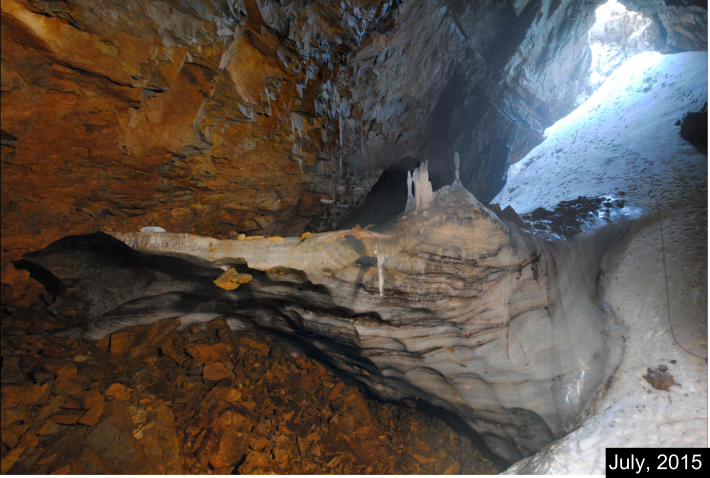Ice cave reveals environmental forcing of long-term Pyrenean treeline dynamics
Pyrenean Institute of Ecology (IPE-CSIC) press release
An international research group led by the Pyrenean Institute of Ecology (IPE-CSIC) in collaboration with the University of Zaragoza, Aberystwyth University (UK) and Bern Universität (Switzerland) have reconstructed long-term treeline dynamics from the Central Pyrenees for the first time.

The results, published in Journal of Ecology, demonstrate that subalpine forests were generally more widely distributed during the last 5700 years, when summer temperatures were warmer than today.
These results are based on a palaeoenvironmental study carried out in the A294 Ice cave discovered by the speleological group Asociación Científica Espeleoógica Cotiella (ACEC). The cave is located in the Central Pyrenees, within the Armeña cirque (Cotiella Massif) at an altitude of 2238 m a.s.l. (200 m higher than the current treeline). This cave houses fossil ice dated between 5700 and 2200 years, and is the oldest known firn ice cave worldwide.
This extraordinary natural archive preserves very diverse frosted remains of pollen and plant macrofossils and therefore is ideal to assess the processes that controlled both local and extra local species dynamics over time. The identification of these plant remains has allowed researchers to study the long-term vegetation dynamics of alpine ecosystems.
The plant macrofossil record shows that altitudinal treeline changes were closely linked to summer temperature changes. 5700 years ago, mountain pines (Pinus uncinata Ramond ex DC) were coexisting with birches (Betula spp.) in the surroundings of the ice cave (2238m a.s.l.), although the maximum altitude reached by the treeline nowadays in the area is 2000 m .a.s.l. Approximately 4200 years ago, a progressive descent of the treeline is observed together with the establishment of alpine meadows dominated by Dryas octopetala as a response to a cooling trend known as neoglaciation. The treeline shifted upwards ca. 3200 years ago and persisted nearby the cave until the end of the record 2200 years ago, when the ice sequence ends. The current landscape is very different to that of 2000 years ago as currently only alpine meadows are present suggesting that during the last two millennia large disturbances, either climatic or human, might have led to a depression of both treelines and timberlines resulting in their current positions in the Armeña cirque.
The long-term sensitivity detected in these subalpine Pyrenean ecosystems can be used as an analogue scenario to their present and future status. The decline of grazing activities during the last decades and the rise in average temperature may eventually lead pines and probably birch communities to move upslope during the next decades modifying alpine species.
The work presented in this article highlights the critical knowledge gap on millennial treeline fluctuations in one of the most important mountain ranges of Europe. The impact of global change on alpine ecosystems and specifically on treeline communities has already been detected, as treelines are slightly expanding and timberlines are thickening at the subalpine belt. These results uphold the centennial to millennial scale perspective as essential for disclosing long-term processes that might be important for sustainable environmental management e.g. in forestry and species conservation. Ice archives are however severely endangered by rising temperatures and more scientific attention is needed in order to rescue their untapped scientific information otherwise essential to assess future ecosystem dynamics under global change conditions.
Read the full article (freely available for a limited time):
Maria Leunda, et al. J Ecol 2018. Ice cave reveals environmental forcing of long-term Pyrenean treeline dynamics. DOI: 10.1111/1365-2745.13077. DOI: 101111./1365-2745.13077
Media contact:
Maria Leunda Esnaola, Pyrenean Institute of Ecology (IPE-CSIC), Email: mleunda@ipe.csic.es
Like what we stand for?
Support our mission and help develop the next generation of ecologists by donating to the British Ecological Society.